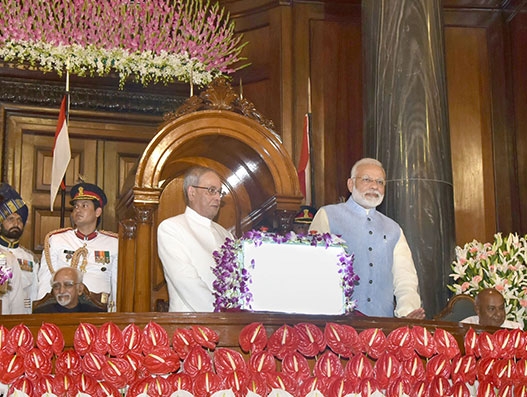
GST, India’s new “tryst with destiny” at the stroke of midnight
<p style="text-align: justify;">July 01, 2017: “At the stroke of the midnight hour, when the world sleeps, India will awake to life and freedom. A moment comes, which comes but rarely in history when we step out from the old to new…” That is an extract from the “tryst with destiny” speech delivered by Jawaharlal Nehru, […]

July 01, 2017: “At the stroke of the midnight hour, when the world sleeps, India will awake to life and freedom. A moment comes, which comes but rarely in history when we step out from the old to new…” That is an extract from the “tryst with destiny” speech delivered by Jawaharlal Nehru, the first Prime Minister of independent India, to the Indian Constituent Assembly in The Parliament, on the eve of India's independence, towards midnight on 15 August 1947. 70 years later towards midnight on 30 June, 2017 India once again made a tryst with destiny stepping out from the old to new. This time it was the official launch of the Goods and Services Tax (GST), the most sweeping tax reform for nearly 70 years.
President of India Pranab Mukherjee launched the new indirect tax regime at the stroke of midnight in the presence of Indian Prime Minister Narendra Modi, his cabinet colleagues and major industry leaders in a special function held at Indian Parliament’s Central Hall.
Prime Minister Modi termed GST, effective from July 1, as a ‘Good and Simple Tax’ and said its introduction was not just a tax or economic reform, but a social reform that would nudge people on the path to honesty and benefit the poor the most.
After 14 years of struggle to enlist the support of India’s states, the GST replaces more than a dozen union and state levies and unify a country of 1.3 billion people into one of the world’s biggest common markets.
Calling the GST a simpler, modern and more transparent taxation system that will do away with 500 different taxes levied across the country’s 29 States and seven Union Territories, the Indian Prime Minister said that it would end the spectre of tax terrorism and Inspector Raj that India’s businesses have had to endure for long. This, he said, would be an outcome of the technological backing for GST implementation, which would do away with grey areas and the resultant discretion the bureaucracy enjoyed over tax payers.
“The implementation of GST would impart much-needed competitiveness to Indian exports with initial hiccups. The spin-off effect on economy particularly on the logistics sector would also help both manufacturing and exports. The refund mechanism through an electronic platform will reduce transaction cost,” said Ganesh Kumar Gupta, President, Federation of Indian Export Organisations (FIEO).
After having series of discussions with the Government of India and awareness programmes jointly organised by the Federation of Freight Forwarders’ Associations in India (FFFAI) and allied logistics associations, customs broking/freight forwarding community and logistics companies in India are all set to comply with the GST.
It is a well-accepted fact that there would be a direct and immediate impact of GST on the logistics industry that includes customs clearance, freight forwarding, warehousing, distribution and supply chain industry in the country. It is also truly estimated by the government that GST would save companies around $14 billion because it would allow them to organise their warehouses and supply chains more efficiently. Firms can now move to demand-based "hub-and-spoke" models used globally, rather than operating state-by-state. As a result, there would be price corrections owing to reduced logistics cost, reduced transaction costs and transit time, and hassle-free transportation for domestic as well as international shipments. Hence, the beneficiary would be Indian manufacturers, exporters and end users owing to Indian products being very competitive.
“The implementation of GST has been at a very appropriate time. Government’s initiatives like Make in India, Trade Facilitation, Single Window Customs Clearance, Ease of Doing Business, Startup India and impetus on domestic consumption as well as cost effective export cargo would definitely receive tremendous boost in long term. The urgent need is to further strengthen those initiatives through appropriate infrastructure, seamless cargo movement and rational/uniform tax policy across the country with proper implementation. GST would not only reduce the cascading tax burden it would also accelerate seamless cargo movement supported by a robust warehousing and distribution mechanism,” said Samir J Shah, Chairman, FFFAI.
Studies have revealed that due to trade barriers such as entry taxes, local body taxes and other hurdles, trucks lie idle for 30 to 40 percent during their delivery schedule. GST is expected to improve transit time because of phasing out the border check posts. According to World Bank, Indian business houses can save up to 30-40 percent of logistic costs burden due to stoppages at various tolls and check posts.
According to Shah, now the concerned area is the implementation of the e-way bill across the country in respect of reaping the logistical benefits of GST. FFFAI believes the Government would take a quick and pragmatic decision in this regard to fully implement the much desired and long-debated tax reform. FFFAI, however, welcomes the government’s decision on two-month relaxation in initial filing requirements to abate teething issues for the larger interest of $2 trillion Indian economy, making it more organised.
The Customs Departments across India have modified its software to comply with the GST regime. In international transport, under GST, the most crucial aspect at the moment is the e-portal of Customs. Other players, including carriers (ocean and air), custodians (ports, airports, container terminals and container freight stations) and Customs brokers, have been preparing for the transition and it should be a smooth sailing. The logistics sector more or less appears geared to migrate to the new taxation system. Reports suggest that most stakeholders in the international transport sector are well-prepared and they don’t anticipate any problems.

